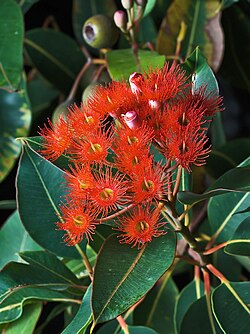Eucalypteae
| Eucalypteae | |
|---|---|

| |
| Angophora hispida | |
| Scientific classification | |
| Kingdom: | Plantae |
| Clade: | Tracheophytes |
| Clade: | Angiosperms |
| Clade: | Eudicots |
| Clade: | Rosids |
| Order: | Myrtales |
| Family: | Myrtaceae |
| Subfamily: | Myrtoideae |
| Tribe: | Eucalypteae |
| Genera | |
|
7, see text | |
Eucalypteae is a large tribe of woody flowering plants with capsule fruiting bodies in the family Myrtaceae; members of this tribe are known as eucalypts.[1][2] In Australia the genera Angophora, Corymbia, and Eucalyptus are commonly known as gum trees, for the sticky substance that exudes from the trunk of some species[3], or stringybarks.[4] As of 2020[update], the tribe comprised around 860 species, all native to Southeast Asia and Oceania, with a main diversity center in Australia.[5]
Genera
[edit]There are seven genera in the tribe Eucalypteae:[1][2][5][6]
- Allosyncarpia S.T.Blake – Australia
- Angophora Cav. – Australia
- Arillastrum Pancher ex Baill. – New Caledonia
- Corymbia K.D.Hill & L.A.S.Johnson – Oceania
- Eucalyptopsis C.T.White – Indonesia, New Guinea
- Eucalyptus L'Hér. – Southeast Asia, Oceania
- Stockwellia D.J.Carr, S.G.M.Carr & B.Hyland – Australia

Taxonomy
[edit]For an example of changing historical perspectives, in 1991, largely genetic evidence indicated that some prominent Eucalyptus species were actually more closely related to Angophora than to other eucalypts; they were accordingly split off into the new genus Corymbia.[citation needed]
Although separate, all of these genera and their species are allied and it remains the standard to refer to the members of all seven genera Angophora, Corymbia, Eucalyptus, Stockwellia, Allosyncarpia, Eucalyptopsis and Arillastrum as "eucalypts" or as the eucalypt group.[6][7][8][9]
The extant genera Stockwellia, Allosyncarpia, Eucalyptopsis and Arillastrum comprise six known species, restricted to monsoon forests and rainforests in north-eastern Australia, the Arnhem Land plateau, New Guinea, the Moluccas and New Caledonia. These genera are recognised as having evolved from ancient lineages of the family Myrtaceae. According to genetic, fossil and morphological evidence, it is hypothesised that they evolved into separate taxa before the evolution of the more widespread and well-known genera Eucalyptus, Corymbia and Angophora, and all of their many species.[6]
Eucalyptus deglupta has naturally spread the furthest from the Australian geographic origin of the genus Eucalyptus, being the only species known growing naturally in the nearby northern hemisphere, from New Guinea to New Britain, Sulawesi, Seram Island to Mindanao, Philippines.[6] Eucalyptus urophylla also grows naturally as far west as the Flores and Timor islands.[6]
Adaptations
[edit]
Eucalypts from fire-prone habitats are attuned to withstand fire in several ways:[10]
- Their seeds are often held in an insulated capsule, which opens only after a bushfire. Once cooled down, the land becomes a freshly fertilised seed bed.
- Oils in the leaves tend to make the fire more severe and therefore more damaging to less attuned species, giving an evolutionary advantage to the eucalypts.
Epicormic buds under the often thick bark of the trunk and branches are ready to sprout new stems and leaves after a fire.[10]
These advantages work well in areas affected by long dry spells.[citation needed]
Over 700 eucalypt species dominate landscapes all over Australia, but diversity is reduced in rainforests and arid environments.
A fungal plant pathogen (from the family Sporocadaceae), Allelochaeta brevilata (H.J. Swart & D.A. Griffiths) Crous is found on species of eucalypts in Australia.[11]
Gallery
[edit]See also
[edit]External links
[edit]- Plant Guide: Eucalyptus, Corymbia and Angophora Archived 2014-01-25 at the Wayback Machine at Australian Native Plants Society
- Eucalypt Research at Currency Creek Arboretum
References
[edit]- ^ a b Wilson, P. G. (2011) Myrtaceae. In The Families and Genera of Vascular Plants. Volume X. Sapindales, Cucurbitales, Myrtaceae, edited by K. Kubitzki, X:212–71. Heidelberg: Springer-Verlag, 2011.
- ^ a b Macphail, Mike; Thornhill, Andrew H. (2016). "How old are the eucalypts? A review of the microfossil and phylogenetic evidence". Australian Journal of Botany. 64 (8): 579. doi:10.1071/BT16124.
- ^ "ANPSA Plant Guide: Eucalyptus, Corymbia and Angophora". anpsa.org.au. Archived from the original on 23 August 2011. Retrieved 26 September 2020.
- ^ "Eucalyptus". Britannica. Retrieved 1 January 2023.
- ^ a b "Myrtaceae Juss". Plants of the World Online. Royal Botanic Gardens, Kew. Retrieved 26 September 2020.
- ^ a b c d e Ladiges, Pauline Y.; Udovicic, Frank; Nelson, Gareth (2003). "Australian biogeographical connections and the phylogeny of large genera in the plant family Myrtaceae". Journal of Biogeography. 30 (7): 989–998. Bibcode:2003JBiog..30..989L. doi:10.1046/j.1365-2699.2003.00881.x. ISSN 1365-2699. S2CID 85895271.
- ^ Lyne, A. 1996 "An Introduction to the Eucalypts The Genera Eucalyptus, Corymbia and Angophora" Centre for Plant Biodiversity Research and Australian National Herbarium. Canberra
- ^ Carr, Denis J.; Carr, S.G.M.; Hyland, Bernie P.M.; Wilson, Paul G.; Ladiges, Pauline Y. (2002). "Stockwellia quadrifida (Myrtaceae), a new Australian genus and species in the eucalypt group". Botanical Journal of the Linnean Society. 139 (4): 415–421. doi:10.1046/j.1095-8339.2002.00062.x.
- ^ Costermans, L. 2006 "Trees of Victoria and adjoining areas".6th ed. ISBN 0-9599105-4-9
- ^ a b Moore, Gregory (2024-02-21). "Hard to kill: here's why eucalypts are survival experts". The Conversation. Retrieved 2025-07-01.
- ^ Crous, P. W.; Wingfield, M. J.; Cheewangkoon, R.; Carnegie, A. J.; Burgess, T. I.; Summerell, B. A.; Edwards, J.; Taylor, P. W. J.; Groenewald, J. Z. (August 2019). "Foliar pathogens of eucalypts". Stud Mycol. 8 (94): 125–298. doi:10.1016/j.simyco.2019.08.001. PMC 6797021. PMID 31636729.




